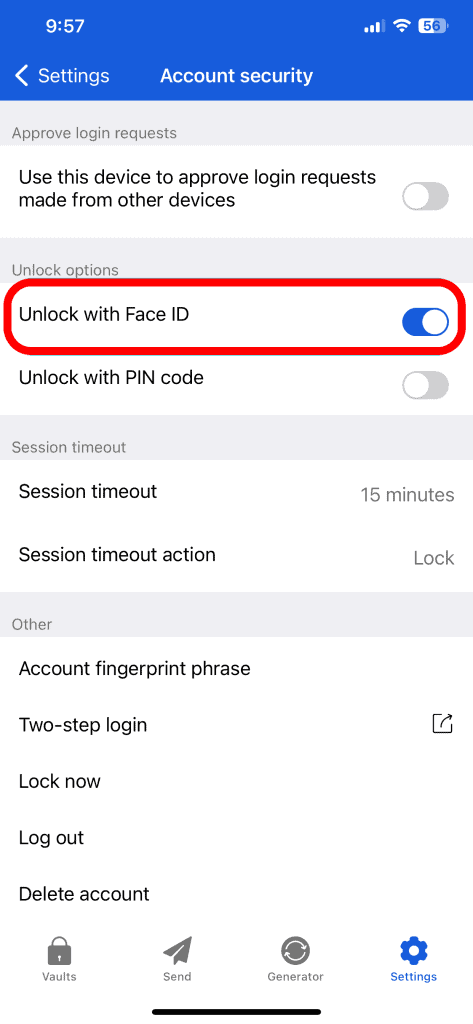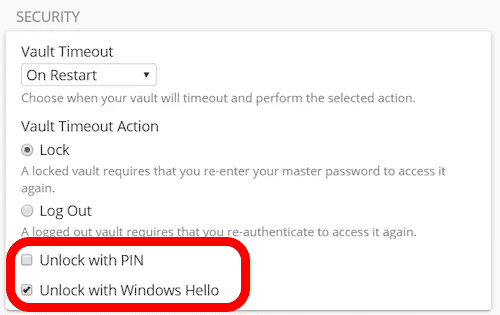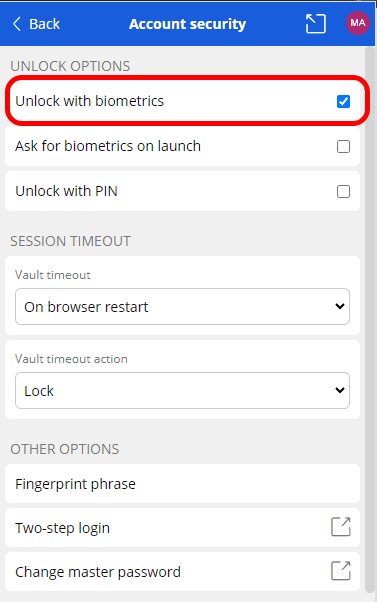Vaultwarden can be configured to accept biometrics as a method to unlock your vault.
Vaultwarden. can only be used to unlock your vault, you will still be required to use your master password or login with device, and any enabled two-step login method when you log in.
Enable unlock with biometrics #
Enable for mobile #
Unlock with biometrics is supported for Android (Google Play or FDroid) via fingerprint unlock or face unlock, and for iOS via Touch ID and Face ID.
To enable unlock with biometrics for your mobile device:
- In your device’s native settings (e.g. the iOS Settings app), make sure your biometric method is turned on.
- In your Passvault app, open the Settings tab.
- Open the Account security section and tap the biometrics option you want to enable.

Tapping the option will prompt you to input your biometric (for example, face or thumb-print). The toggle will fill in when unlock with biometrics is successfully enabled.
Enable for desktop #
Unlock with biometrics is supported for Windows via Windows Hello using PIN, Facial Recognition, or other hardware that meets Windows Hello biometric requirements and for macOS via Touch ID.
Unlock with biometrics is set separately for each account logged in to the desktop app. To enable unlock with biometrics:
- In your device’s native settings (for example, the macOS System Preferences app), make sure your biometric method is turned on.TipWindows users may need to install the Microsoft Visual C++ Redistributable before Windows Hello can be turned on in desktop preferences.
- In your Passvault app, open your Settings (on Windows, File → Settings) (on macOS, Passvault → Preferences).

3. Optionally, select either the Require password (or PIN) on app start or Ask for biometric on app start option to set how your desktop app will behave when you start the the app.
Enable for browser extensions #
To enable unlock with biometrics for your browser extension:
Biometrics (Windows Hello or Touch Id) must be enabled in your desktop app before proceeding. If you don’t see the Windows Hello option in your desktop app, you may need to install the Microsoft Visual C++ Redistributable. Additionally, if you are using Safari, you can skip straight to step 4.
- In your Passvault desktop app, navigate to settings (on Windows, File → Settings) (on macOS, Passvault → Preferences).
- Scroll down to the options section, and check the Allow browser integration box.NoteOptionally, check the Require verification for browser integration option to require a unique fingerprint verification step when you activate the integration.
- In your Browser, navigate to the extensions manager (e.g.
chrome://extensionsorbrave://extensions), open Passvault , and toggle the Allow access to file URLs option.Not all browsers will require this to be toggled on, so feel free to skip this step and circle back to it only if the remaining procedure doesn’t work. - In your browser extension, open the Settings tab.
- Select Account security and check the Unlock with biometrics box.TipYou may be prompted at this stage to allow Passvault to
communicate with cooperating native applications. This permission is safe, but optional and solely enables the browser extension to communicate with desktop as described above.You will be prompted by your desktop app to input your biometric. Doing so will complete the initial setup procedure. If you have opted to require verification (step two), you will need to approve a fingerprint validation check. - If you want the browser extension to automatically prompt for your biometric input when launched, make sure the Prompt for biometrics on launch option is on.
The browser extension will automatically prompt for your biometric when you open it. If you turn the prompt option (step six), use the Unlock with biometrics button on the Unlock screen:




